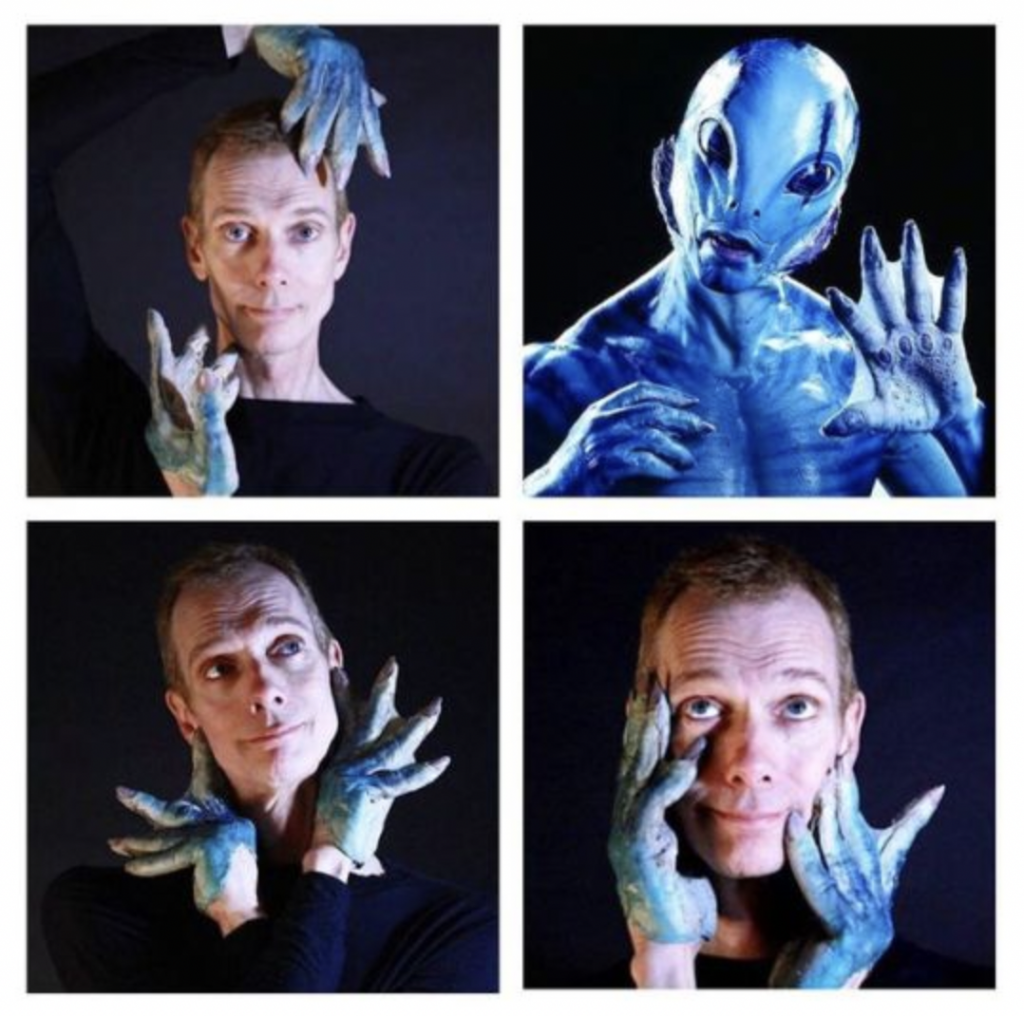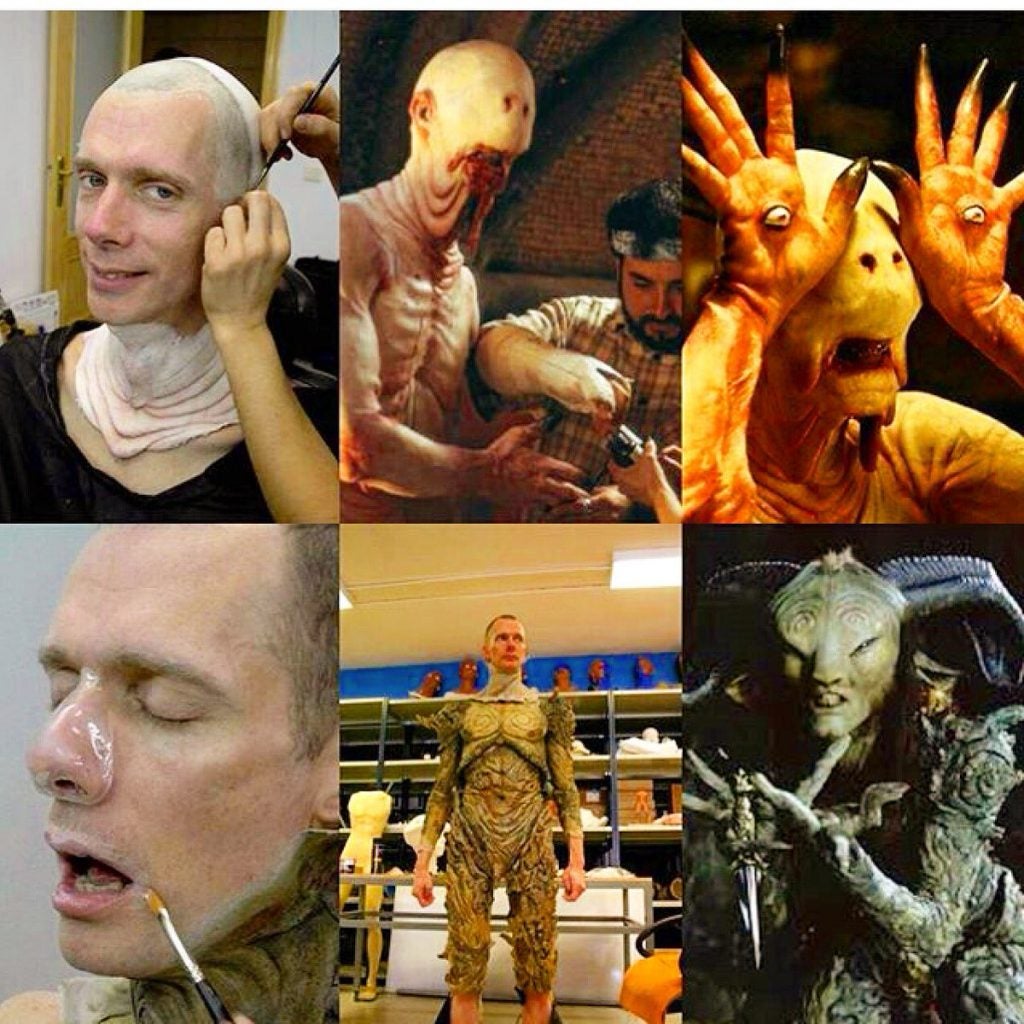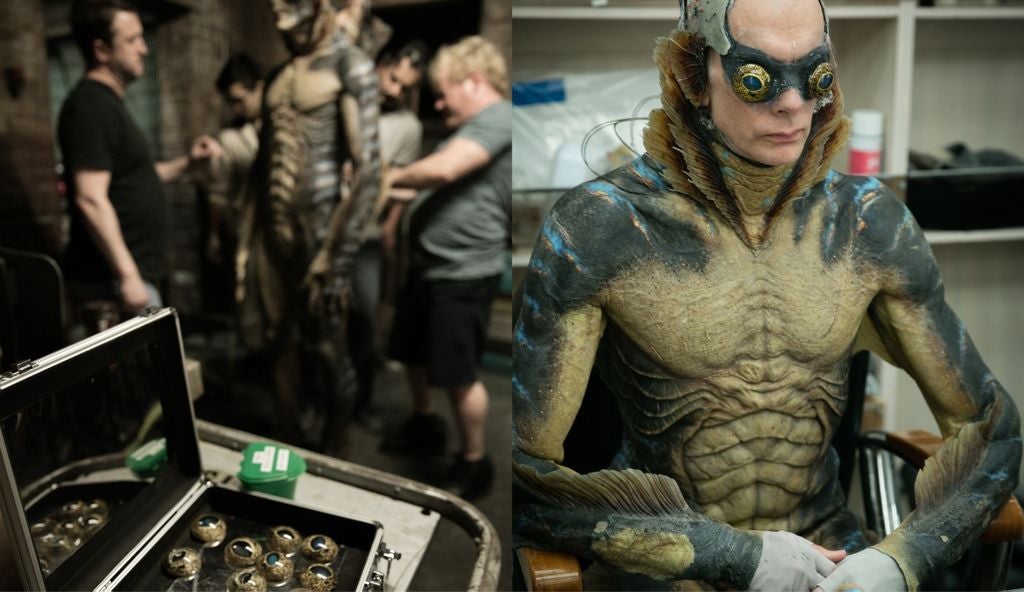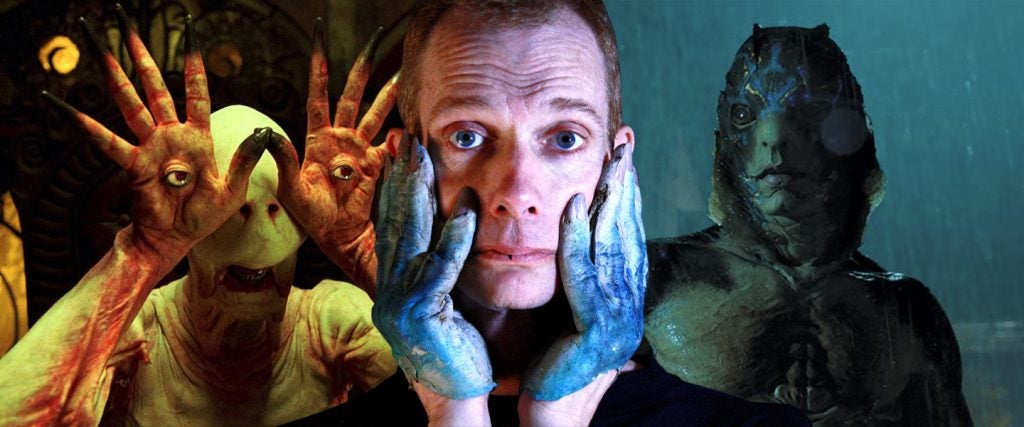In an era of Hollywood where a CGI Thanos can dominate an Avengers movie, or a CGI chimpanzee can lead an entire Planet of the Apes trilogy, the demand for practical effects has declined. However, there are a few filmmakers who still prefer their tangibility — none more so than Oscar-winner Guillermo del Toro. An auteur who’s found success in horror, science fiction, fantasy and even romance, del Toro is a filmmaker with a distinct style and vision, particularly when involving the monsters and creatures in his work. To help him realize those creations, del Toro has turned to the same man time and time again: Doug Jones.
From Abe Sapien in the Hellboy films to The Faun in Pan’s Labyrinth to the romantic lead in The Shape of Water, Jones’ unique physicality and talents as an actor have made him Hollywood’s go-to monster. Even outside of his work with del Toro, Jones has brought life to characters like the much-beloved Billy Butcherson in Hocus Pocus, the Silver Surfer in the second Fantastic Four film and Commander Saru in Star Trek: Discovery. If you need a movie monster in five hours of makeup and prosthetics, he’s your guy.
Below, he shares what it’s been like to take on cinema’s most iconic monster roles, including the one where it all started — a bizarre, moon-headed singer trying to convince people to eat Big Macs after 6:30 p.m.
Mac Tonight for McDonald’s (1986)
Don Knotts on The Andy Griffith Show: That was the part I wanted to play when I went out to Hollywoodland in 1985. I wanted to be the goofy next-door neighbor or the funny guy in commercials — that’s just what I related to. Growing up in Indiana, I was the youngest of four boys, and they were all popular and athletic. I was this skinny, goofy kid, so watching goofy people on television made me want to be a part of that.
I had watched horror movies, too. They were haunting, inspiring, beautiful and dark, but I never thought of that as a career option. Then I got an agent. He had me put “contortionist” and “mime” on my resume — I was very flexible, and I’d been a part of a mime troupe in college. When I started auditioning for commercials, he sent me out on anything physically tomfoolery-ish, and the first commercial I booked was for Southwest Airlines as a dancing mummy. Since Boris Karloff’s The Mummy had been the first monster movie I saw, it felt full-circle-ish.
I did a few more commercials, and then my fourth booking was the Mac Tonight campaign for McDonald’s — it ended up being so successful that it lasted for 27 commercials. They just kept going and going, and by the end of their run, I’d worked with so many people in the creature effects business that people started to learn who I was.
That moon head was heavy, though! It was a full 10-plus pounds on a skinny boy’s neck — as I learned early on, it usually doesn’t look good until it hurts. At first, those roles are fun — to totally transform yourself into an otherworldly creature is exciting. But eventually, you have to start persevering instead of playing. It becomes more about buckling down and putting your athlete’s mindset to work and pushing through to the finish line. Then, when you see the finished product, you realize that all the pain and suffering was worth it.
Billy Butcherson in ‘Hocus Pocus’ (1993)
I was in Batman Returns in a non-memorable role, but having that on my resume helped get me seen for Hocus Pocus. At first, I didn’t think Hocus Pocus was going to be a big deal — my part was originally just one line, and when the movie came out in July 1993, it didn’t do that well. None of us had any idea that Hocus Pocus would become the annual event that it is today.
I loved playing Billy. For one thing, he’s human — he’s a dead human — but he was still human, and the farther you get away from human, the more uncomfortable you’re going to be. He was fun — I was able to give him some goofy, floppy limbs, and I got to be a zombie before zombies were cool. He was handsome too! They gave me a little more cheekbone, and I thought Billy looked pretty good.
Now, when I do the convention circuit, I hear so much about Billy Butcherson from fans and how they’ve grown up with him. It reminds me of the Scarecrow in The Wizard of Oz, because I grew up with him. It’s the biggest compliment that that role meant so much to people. And, now I get to play him again in Hocus Pocus 2, which I’m working on right now.
Abe Sapien in ‘Hellboy’ (2004) and ‘Hellboy II: The Golden Army’ (2008)
I met Guillermo del Toro on the set of Mimic, which was his first American film. They filmed it in Toronto, but I was called in months later when they were doing pick-up shots — the movie was coming out in three weeks and it was too expensive and time-consuming to get the Canadian actors down to Los Angeles. Out came the “tall skinny guy Rolodex,” and I got the call to be a bug man. I was out of work, so I jumped at the opportunity. I ended up doing a few days on the film, and the second day was when I really met Guillermo.
During lunch, he sat across the table from me and said, “Tell me everything you’ve been in before.” This was 1997, so I’d been in a few movies by this point, and with every one I mentioned, Guillermo knew who the creature shop was and who the artists were that put me into makeup. He had such an encyclopedia in his head, and we had a mutual love for creepy-crawly things, so we were like two kids talking. It wasn’t the typical chat.
Five years later, I’d gone on to do a bunch of other things, and I got another random phone call, this time from Steve Wang from Spectral Motion talking about this part for a director who knew me. That ended up being Guillermo del Toro working on the first Hellboy, where I would play Abe Sapien. I’d given Guillermo my card when I did Mimic, and five years later, he still had that card in his wallet.
The only downside of playing Abe Sapien was that my voice was dubbed. I don’t want to whine about it, but no actor wants to see part of their performance erased. I knew that was a possibility going in because the studio had wanted more names attached to the film, including for the voice of Abe Sapien. To his credit, Guillermo tried to use my voice — I even did all the ADR for the part — but then the studio returned to the idea of a big name for Abe, so David Hyde Pierce was brought in for it.
To this day, I’ve never met David Hyde Pierce, but when I do, I’m going to kiss his left cheek and say, “Thank you for the gift you gave me.” See, there were a number of very sweet things that happened with this role, and a couple of them came from David Hyde Pierce himself. The story goes that when he came in to record, he had his headset on, and he heard my voice while watching my work on screen. He took his headset off and said, “I’m not sure what I’m doing here,” which is such a sweet thing for him to say. He ended up doing the job he was hired for, but when the film came out, his name didn’t appear in the credits at all, and that was at his request. When asked why, he said, “That’s out of respect for Doug Jones.”
He also did no press for the movie, and didn’t show up for the red carpet — he let me have all that. Also, in between the two Hellboy films, there were two animated films of Hellboy with Ron Perlman and everyone else from the movie. But David Hyde Pierce, bless his heart, declined to return. After that, they used another voice that was mimicking David Hyde Pierce’s. During his session, Ron Perlman heard that guy and said, “Who’s that?” They explained what happened, and he said, “Just get Doug, he was perfect.” Then I got the call for those.

Another sweet thing that happened during the first Hellboy was that Guillermo didn’t let me find out about my voice being replaced in The Hollywood Reporter. He called me and told me what was going to be announced. When I asked him whether it was a performance issue, he assured me it wasn’t. Not only that, but he said, “If we get blessed enough to do Hellboy II, I’ll use your voice for that.” So, when Hellboy II came along, Guillermo lived up to his promise.
Starting with Hellboy II, I’ve had it in my contract that, if a film is in English, it will be my voice. That really protected me because, after the first Hellboy, a similar thing happened when I played the Silver Surfer. With that one, I ended up reading in The Hollywood Reporter that Laurence Fishburne was going to be the voice. That was just two days after I’d done my voice-looping session for the Silver Surfer, so it was obvious that it was already in the works.
I’m grateful for the parts I’ve gotten to play, but I’ve struggled in my career with sometimes being considered a “suit actor” or “suit performer” instead of just an “actor,” which is what I am. It’s been a career-long journey for me to take the term “suit actor” and trash it forever. I don’t want any of my cohorts to be called “suit actors” or “suit performers.” It sounds like a downgraded position, and it also gives a studio a reason to downgrade you and save money. It takes an actor to take on a character, period.
The Faun and The Pale Man in ‘Pan’s Labyrinth’ (2006)
When Guillermo did Pan’s Labyrinth, he wrote The Faun and The Pale Pan with me in mind. He told me I had to do them and I didn’t have a choice. I was terrified that I was going to ruin the movie because The Faun was all in Spanish, and I don’t speak Spanish. I told Guillermo, “I’m going to ruin your movie,” and he said, “You have to do this. Count to 10 for all I care. I’ll dub over it later.”
That was comforting, but I couldn’t do that to him, and I couldn’t do it to the 11-year-old actress who I shared my scenes with. And so, I buckled down and learned the Spanish lines word-for-word. It was the hardest thing I’ve ever done, delivering that dialogue with a five-hour makeup job on top of me. But, a year later, I was attending the Oscars for the first time for a film with six nominations. It was a lovely ride, and that was the film where the comparisons started to be made about bringing back the golden era of monsters.

I’d never really been a talk show guest before that and I didn’t expect to be interviewed by Joan Rivers on the red carpet, but I was. That film was a game changer for me. It was the biggest thing I’d done up until that point, and it remained so until 2017 with The Shape of Water.
Amphibian Man in ‘The Shape of Water’ (2017)
Heading into The Shape of Water, we knew comparisons were going to be made with Abe Sapien, a movie by Guillermo del Toro with Doug Jones as a fish man. It was unavoidable, but Guillermo was very distinct about their differences. Abe is a comic book character who was very intelligent and well-spoken, but the Amphibian Man was a raw animal from nature. To remind me of that when he was directing me, Guillermo would say “Dougie!” then he’d growl at me — it became the shorthand to remind me that this was an animal.
The Shape of Water was my first real romantic part, and that was a new challenge. I’ve heard Guillermo talk about his inspiration for the film, and it came from Creature from the Black Lagoon where Julie Adams is swimming on the surface of the water while the gill man was swimming below her. When he was a kid, Guillermo was mesmerized by that image, and thought, “I hope they end up together.” Of course, they didn’t, but part of what we wanted to do with The Shape of Water was to fulfill that kind of relationship between a human and an inhuman monster, like in Creature from the Black Lagoon and King Kong.

To pull that off — for you to buy that romance — this fish man had to look sexy. The design of that creature took about a year. His lips went through a lot of reshapes and recolors to make sure they were kissable, and there was a lot of talk about his butt. On set, I knew the ass was working when, on more than one occasion, Octavia Spencer would give a quick “Mmm” when I stood up and walked away.
For my own physicality, one thing I learned pretty quickly was to lead with the pelvis — that was a direction from Guillermo. That helped distinguish him from Abe Sapien — who stood very straight with an arched back. With this creature, Guillermo wanted me to move like a matador. Bullfighting is brutal, but it’s steeped in history, and there’s a certain dance to it where the matador leads in a sexy fashion. So, I was thinking “pelvis first” when I was out of the water.
It was amazing to me that he could make the Amphibian Man sexual in one scene and then have him eat a cat in another. It’s a credit to him as a director — he’s the only one who could pull that off. He is the visionary who has the writing skills and the heart and the desire to make monsters luscious again. He’s brought that old-school monster back, and I’ve just been tickled pink to be a part of the ride.

